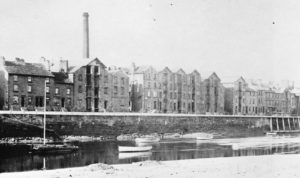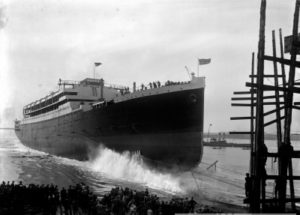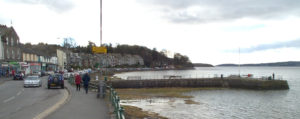As Malcolm says ports were places that moved things, food, people, military equipmen, goods and acted as places for ship building.Barrow at the end of the longest cul de sac in the country had a population in the 1850’s of 500, small in comparison to nearby Ulverston at 5, 500.
Haverigg apparently had the richest iron ore found in England leading to a small steel works being founded at Millom and with nearby coal and limestone being readily available business was quick to take off, necessitating a larger steel works having to be built. Of course ship building needed steel and people flocked to the area which offered plenty of employment opportunities and Barrows’ population rose considerably.
At one mile long, Ulverston has the shortest canal in England which because it became uneconomical to run was sealed off and is now used for pleasure craft. Ulverston was seen as a good port to get in and out of. Boats were able to tie up at the quay or the promenade.

St George’s Quay, Lancaster, Courtesy of Malcolm Tranter
Storth and Arnside became the port for Milnthorpe . A customs house was built close to the quay in common with many ports, enabling the government to ‘get their cut’ via taxation. When the railways arrived small ports like Storth were cut off.
Sunderland Point does not easily spring to mind as a port and was a tiny isolated community but survived at one point by transporting road stone to North Wales in a very small way. Warning – if you intend to visit this area check the tide times!
Richard Gillow a member of the famous family built the Custom House in Lancaster. If you visit Lancaster be sure to visit St. George’s Quay warehouses, grand buildings most probably converted to homes by now. Some goods were kept in bonded warehouses for example spices, rum, pepper. Barrels were leak proof, the shape and size differed for identification. Hogs head barrels held 63 gallons.
Lancaster was involved in a ‘triangular trade’, ships took goods to ports on the west African coast, the profits bought slaves who were then transported to the USA and after collecting more profits, cotton was transported to Lancashire. People bought shares in this very profitable business but at the time could not have been aware of the appalling conditions on the middle leg of the journey.
During the fallow summer season fishermen supplemented their income by taking visitors on pleasure trips around Morecambe bay. The port of Glasson Dock is also worth a visit, it was built to accommodate ships that were bigger and deeper drafted and also had a small line in ship building. Some of the warehouses stored grain and some are still there today alongside pleasure craft. The five mile long canal here connects to the Lancaster canal. Goods were loaded from ships onto barges and travelled to Preston and Kendal.

Barrow Ship Launch, Courtesy of Malcolm Tranter
Heysham, Cockersands, Fleetwood, Wyre dock, Blackpool, Lytham, Preston, dredging, sifting, steam houses, pilots, tugs, lifeboats, ship breakers yards, wood pulp, asparto grass, china clay, 500 pits within five miles of Wigan college, coal, pit props, wood, phew! Reader I could go on, this was an extremely interesting talk on the decline of the fishing industry and ports along the coast of northwest Lancashire. Between the advent of the railways, the ‘Cod Wars’ and Roll off Roll on ferries and container ships the industry and these charming working ports saw their demise. However, some of them have very interesting museums and they are well worth a trip to inform yourselves further of their place in our Lancashire heritage.
Did you know that:
A convict ship was moored off the coast at Heysham to house felons, as at one point in time there were not enough ships to take them to their ‘new’ life in Australia.
Wyre dock later housed the Freeport shopping centre.

Arnside Loading Area,
Courtesy of Malcolm Tranter
At Fleetwood the lighthouse is in the middle of the town and was one of three lights that when they were visually lined up from out at sea, guided the boats home to the landing point.
Lytham was set up as an extra port for Preston when the sea traffic became too much to handle.
The river was ‘moved’ at Preston to build the docks.
It is ironic that Preston was asked to trial Roll on Roll off ferries and containers as this was a factor in a lot of small ports closing.
Preston docks of which there were six and a half miles, worked a 24 hour day in the 1960’s, sadly by 1981 the port had closed, it was totally uneconomic as 60% of the profits were spent on dredging.
Banner Image: Original Preston Quay, Courtesy of Malcolm Tranter